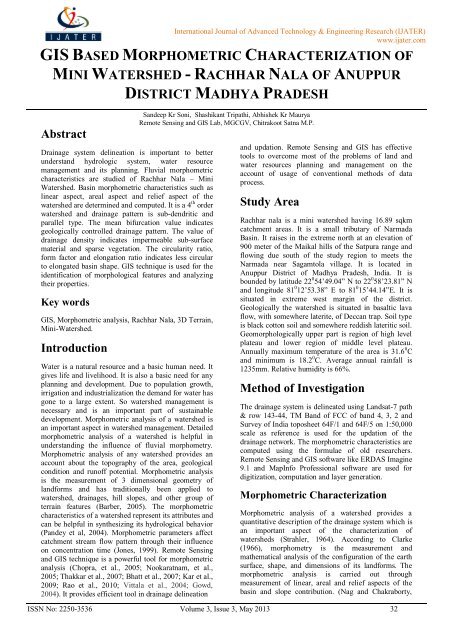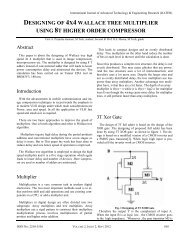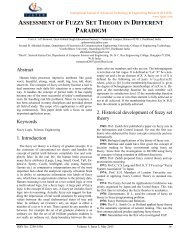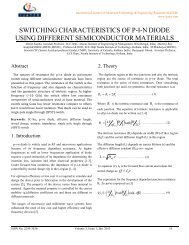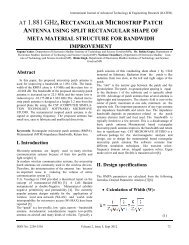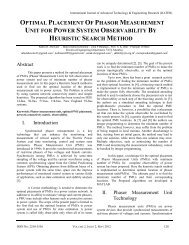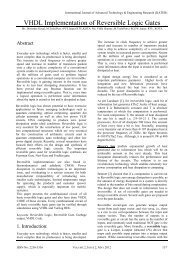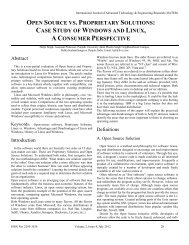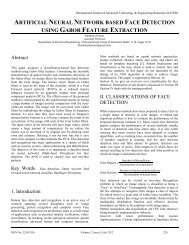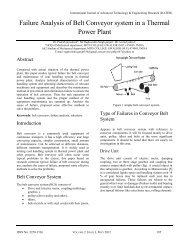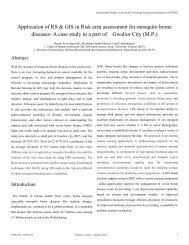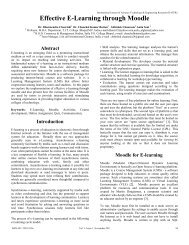gis based morphometric characterization of mini watershed - ijater
gis based morphometric characterization of mini watershed - ijater
gis based morphometric characterization of mini watershed - ijater
Create successful ePaper yourself
Turn your PDF publications into a flip-book with our unique Google optimized e-Paper software.
International Journal <strong>of</strong> Advanced Technology & Engineering Research (IJATER)www.<strong>ijater</strong>.comGIS BASED MORPHOMETRIC CHARACTERIZATION OFMINI WATERSHED - RACHHAR NALA OF ANUPPURAbstractDISTRICT MADHYA PRADESHDrainage system delineation is important to betterunderstand hydrologic system, water resourcemanagement and its planning. Fluvial <strong>morphometric</strong>characteristics are studied <strong>of</strong> Rachhar Nala – MiniWatershed. Basin <strong>morphometric</strong> characteristics such aslinear aspect, areal aspect and relief aspect <strong>of</strong> the<strong>watershed</strong> are determined and computed. It is a 4 th order<strong>watershed</strong> and drainage pattern is sub-dendritic andparallel type. The mean bifurcation value indicatesgeologically controlled drainage pattern. The value <strong>of</strong>drainage density indicates impermeable sub-surfacematerial and sparse vegetation. The circularity ratio,form factor and elongation ratio indicates less circularto elongated basin shape. GIS technique is used for theidentification <strong>of</strong> morphological features and analyzingtheir properties.Key wordsGIS, Morphometric analysis, Rachhar Nala, 3D Terrain,Mini-Watershed.IntroductionWater is a natural resource and a basic human need. Itgives life and livelihood. It is also a basic need for anyplanning and development. Due to population growth,irrigation and industrialization the demand for water hasgone to a large extent. So <strong>watershed</strong> management isnecessary and is an important part <strong>of</strong> sustainabledevelopment. Morphometric analysis <strong>of</strong> a <strong>watershed</strong> isan important aspect in <strong>watershed</strong> management. Detailed<strong>morphometric</strong> analysis <strong>of</strong> a <strong>watershed</strong> is helpful inunderstanding the influence <strong>of</strong> fluvial morphometry.Morphometric analysis <strong>of</strong> any <strong>watershed</strong> provides anaccount about the topography <strong>of</strong> the area, geologicalcondition and run<strong>of</strong>f potential. Morphometric analysisis the measurement <strong>of</strong> 3 dimensional geometry <strong>of</strong>landforms and has traditionally been applied to<strong>watershed</strong>, drainages, hill slopes, and other group <strong>of</strong>terrain features (Barber, 2005). The <strong>morphometric</strong>characteristics <strong>of</strong> a <strong>watershed</strong> represent its attributes andcan be helpful in synthesizing its hydrological behavior(Pandey et al, 2004). Morphometric parameters affectcatchment stream flow pattern through their influenceon concentration time (Jones, 1999). Remote Sensingand GIS technique is a powerful tool for <strong>morphometric</strong>analysis (Chopra, et al., 2005; Nookaratnam, et al.,2005; Thakkar et al., 2007; Bhatt et al., 2007; Kar et al.,2009; Rao et al., 2010; Vittala et al., 2004; Gowd,2004). It provides efficient tool in drainage delineationSandeep Kr Soni, Shashikant Tripathi, Abhishek Kr MauryaRemote Sensing and GIS Lab, MGCGV, Chitrakoot Satna M.P.and updation. Remote Sensing and GIS has effectivetools to overcome most <strong>of</strong> the problems <strong>of</strong> land andwater resources planning and management on theaccount <strong>of</strong> usage <strong>of</strong> conventional methods <strong>of</strong> dataprocess.Study AreaRachhar nala is a <strong>mini</strong> <strong>watershed</strong> having 16.89 sqkmcatchment areas. It is a small tributary <strong>of</strong> NarmadaBasin. It raises in the extreme north at an elevation <strong>of</strong>900 meter <strong>of</strong> the Maikal hills <strong>of</strong> the Satpura range andflowing due south <strong>of</strong> the study region to meets theNarmada near Sagamtola village. It is located inAnuppur District <strong>of</strong> Madhya Pradesh, India. It isbounded by latitude 22 0 54’49.04” N to 22 0 58’23.81” Nand longitude 81 0 12’53.38” E to 81 0 15’44.14”E. It issituated in extreme west margin <strong>of</strong> the district.Geologically the <strong>watershed</strong> is situated in basaltic lavaflow, with somewhere laterite, <strong>of</strong> Deccan trap. Soil typeis black cotton soil and somewhere reddish lateritic soil.Geomorphologically upper part is region <strong>of</strong> high levelplateau and lower region <strong>of</strong> middle level plateau.Annually maximum temperature <strong>of</strong> the area is 31.6 0 Cand <strong>mini</strong>mum is 18.2 0 C. Average annual rainfall is1235mm. Relative humidity is 66%.Method <strong>of</strong> InvestigationThe drainage system is delineated using Landsat-7 path& row 143-44, TM Band <strong>of</strong> FCC <strong>of</strong> band 4, 3, 2 andSurvey <strong>of</strong> India toposheet 64F/1 and 64F/5 on 1:50,000scale as reference is used for the updation <strong>of</strong> thedrainage network. The <strong>morphometric</strong> characteristics arecomputed using the formulae <strong>of</strong> old researchers.Remote Sensing and GIS s<strong>of</strong>tware like ERDAS Imagine9.1 and MapInfo Pr<strong>of</strong>essional s<strong>of</strong>tware are used fordigitization, computation and layer generation.Morphometric CharacterizationMorphometric analysis <strong>of</strong> a <strong>watershed</strong> provides aquantitative description <strong>of</strong> the drainage system which isan important aspect <strong>of</strong> the <strong>characterization</strong> <strong>of</strong><strong>watershed</strong>s (Strahler, 1964). According to Clarke(1966), morphometry is the measurement andmathematical analysis <strong>of</strong> the configuration <strong>of</strong> the earthsurface, shape, and dimensions <strong>of</strong> its landforms. The<strong>morphometric</strong> analysis is carried out throughmeasurement <strong>of</strong> linear, areal and relief aspects <strong>of</strong> thebasin and slope contribution. (Nag and Chakraborty,ISSN No: 2250-3536 Volume 3, Issue 3, May 2013 32
2003). Various <strong>morphometric</strong> parameters such as linearaspects <strong>of</strong> the drainage network: stream order (Nu),bifurcation ratio (Rb), stream length (Lu) and arealaspects <strong>of</strong> the drainage basin: drainage density (D),stream frequency (Fs), texture ratio (T), elongation ratio(Re), circularity ratio (Rc), form factor ratio (Rf) <strong>of</strong> thebasin are computed through GIS technique.Linear Aspects <strong>of</strong> the Channel SystemStream Number & Stream Order (Nu): For drainagebasin analysis it is important to demonstrate streamorders which are initial work for <strong>morphometric</strong> analysis.In the present study, the channel segment <strong>of</strong> thedrainage basin has been ranked according to Strahler’s(1952) stream ordering system. In the system fingertipstream has lowest order while trunk stream throughwhich all discharge <strong>of</strong> water and sediment passes hashighest order. The catchment area <strong>of</strong> the <strong>mini</strong><strong>watershed</strong> is a 4 th order drainage basin. Total number <strong>of</strong>80 streams were identified <strong>of</strong> which 58 are 1 st orderstreams, 16 are 2 nd order, 5 are 3 rd order and one isindicating 4 th order stream. Drainage patterns <strong>of</strong> thestream network from the basin have been observed asmainly sub-dendritic type while in some parts <strong>of</strong> thebasin represent parallel type (Regression logarithm alsosupport).Bifurcation Ratio (Rb): The term bifurcation ratio(Rb) is used to express the ratio <strong>of</strong> the number <strong>of</strong>streams <strong>of</strong> any given order to the number <strong>of</strong> streams innext higher order (Schumn, 1956). Bifurcation ratioscharacteristically range between 3.0 and 5.0 for basinsin which the geologic structures do not disturb thedrainage pattern (Strahler, 1964). The mean bifurcationratio value is 3.94 for the study area which indicatesthat the geological structures are less disturbing thedrainage pattern. Higher values <strong>of</strong> Rb indicate a strongstructural control in the drainage pattern.Stream Length (Lu): Stream length is the length <strong>of</strong> allthe streams having order u. It indicates the contributingarea <strong>of</strong> the basin <strong>of</strong> that order. It is one <strong>of</strong> the mostsignificant hydrological features <strong>of</strong> the basin as itreveals surface run<strong>of</strong>f characteristics streams <strong>of</strong>relatively smaller lengths are characteristics <strong>of</strong> areaswith larger slopes and finer textures. Longer lengths <strong>of</strong>streams are generally indicative <strong>of</strong> flatter gradients.Generally, the total length <strong>of</strong> stream segments ismaximum in first order streams and decreases as thestream order increases. The number <strong>of</strong> streams <strong>of</strong>various orders in the basin is counted and their lengthsfrom mouth to drainage divide are measured with thehelp <strong>of</strong> GIS s<strong>of</strong>tware.Areal Aspects <strong>of</strong> the Drainage Basin:Drainage Density (Dd): Drainage density is animportant factor for land forms element in streameroded topography. It was introduced by Horton (1945).It is the ration <strong>of</strong> total stream length within a basin tothe basin area. In the drainage density analysis Gridmethod is used in which 1 sq.km grids are used as areaand length <strong>of</strong> streams are measured in the area <strong>of</strong> 1International Journal <strong>of</strong> Advanced Technology & Engineering Research (IJATER)www.<strong>ijater</strong>.comsq.km. The value drainage density varies from 1.08 to4.88 km/km 2 . In average measurement <strong>of</strong> drainagedensity the value is found as 3.30 km/km 2 . It shows thecloseness <strong>of</strong> spacing <strong>of</strong> streams. Drainage density givesan idea about the physical properties <strong>of</strong> the underlyingrocks in the study area.Stream Frequency (Fs): Stream frequency wasintroduced by Horton (1945). It is defined as the totalnumber <strong>of</strong> stream segments <strong>of</strong> all orders per unit area.Its value indicates positive correlation with the drainagedensity suggesting increase in stream population withrespect to increase in drainage density.Texture Ratio (Dt): Drainage texture is the totalnumber <strong>of</strong> stream segments <strong>of</strong> all orders per perimeter<strong>of</strong> that area (Horton, 1945). It is one <strong>of</strong> the importantconcepts <strong>of</strong> geomorphology which means that therelative spacing <strong>of</strong> drainage lines. Smith (1950)classified drainage density into five classes i.e., verycoarse (8).Form Factor Ratio (Rf): This factor determines aboutthe shape <strong>of</strong> the basin. Form factor is defined as theratio <strong>of</strong> basin area to the square <strong>of</strong> the basin length(Horton, 1932). For perfectly circular basin the valueshould be greater than 0.78. Smaller the value, moreelongated will be the basin.Circularity Ratio (Rc): It is the ratio <strong>of</strong> the area <strong>of</strong> thebasins to the area <strong>of</strong> circle having the samecircumferences as the perimeter as the basin (Miller,1953). It is influenced by the length and frequency <strong>of</strong>streams, geological structures, land use/land cover,climate and slope <strong>of</strong> the basin.Elongation Ratio (Re): It is the ratio between thediameter <strong>of</strong> the circle <strong>of</strong> the same area as the drainagebasin and the maximum length <strong>of</strong> the basin. High Revalues indicate that the areas are having high infiltrationcapacity and low run<strong>of</strong>f. Values nearing 1.0 are typical<strong>of</strong> regions <strong>of</strong> low relief, whereas values in the range <strong>of</strong>0.6 to 0.8 are generally associated with strong relief andsteep ground slopes. For the study area the value is0.67.Basin Shape (Bs): Basin shape determines about peakflow or flood discharge. It is the ratio <strong>of</strong> square <strong>of</strong> thebasin length to the area <strong>of</strong> the basin. Lesser valueindicates sharply peaked water flow which may happento flood. Higher the value indicates weaker flooddischarge period or weaker out flow. For the study areavalue is 2.78 which is a higher value.Length <strong>of</strong> Overland Flow (Lb): The length <strong>of</strong>overland flow is equals to half <strong>of</strong> reciprocal <strong>of</strong> drainagedensity. It is length <strong>of</strong> water over the ground before itgets concentrated into definite stream channels (Horton,1945). In the study area value is 0.15 indicating highrelief.Relief Aspect <strong>of</strong> the Drainage BasinISSN No: 2250-3536 Volume 3, Issue 3, May 2013 33
Relative Relief: It is the maximum vertical distancebetween the lowest and the highest points <strong>of</strong> the basin.The maximum height <strong>of</strong> the basin is 900m and thelowest is 700m. Therefore, the relief <strong>of</strong> the basin is200m.Relief Ratio: It is defined as the ratio <strong>of</strong> horizontaldistance along the longest dimension <strong>of</strong> the basinparallel to the principal drainage line (Schumn, 1956). Itmeasures the overall steepness <strong>of</strong> a drainage basin andis an indicator <strong>of</strong> the intensity <strong>of</strong> erosion processesoperating on the slopes <strong>of</strong> the basin.Result & ConclusionGeographical Information System (GIS) tools are usedin the drainage delineation and their updation.Morphometric analysis is carried out through updateddrainage. Linear aspects, areal aspects and relief aspects<strong>of</strong> the basin are measured for the analysis. Drainagepattern <strong>of</strong> the study area is sub-dendritic and parallelwith moderate drainage texture. Sub-dendritic drainagepattern <strong>of</strong> the study area exhibit homogeneity in textureand lack <strong>of</strong> structural control but parallel drainagepattern suggest that the area has a gentle, uniform slopesand with less resistant bed rock. The mean bifurcationratio value is 3.94 which indicates geologicallycontrolled drainage pattern. The average value <strong>of</strong>drainage density for the basin area is 3.30 while in Gridmethod measurement the value varies from 1.08 to 4.88km/km 2 . In the drainage density map analysis it is foundthat maximum basin area is covered in mediumdrainage density value which indicates medium surfacerun<strong>of</strong>f, moderate impermeable sub-surface material,moderate sparse vegetation, steep to high relief and welldeveloped network. Drainage texture is moderate. Thevalue <strong>of</strong> stream frequency indicates +ve correlation withincreasing stream population with respect to increasingdrainage density. The value <strong>of</strong> circularity ratio indicatesmore or less circular in shape and the area ischaracterized by high relief and the drainage system iscontrolled. The value <strong>of</strong> elongation ratio indicateselongated basin with high relief and steep slopes andsomewhere gentle slope. The value <strong>of</strong> form factorindicates flatter peak flow for longer duration andelongated in shape. The value <strong>of</strong> basin shape indicatesweaker flood discharge period or weaker outflow. In 3Dview analysis <strong>of</strong> the basin area, it is found that streamsare originated from high relief or high slope region thencomes to steep slope region and then flows in gentleslope area to meet the Narmada River. Due to mediumdrainage density and slope the basin area indicatesmoderate ground water recharge zone. The<strong>morphometric</strong> characteristics evaluated using GIShelped us to understand various terrain parameterswhich are important for basin area planning andmanagement.AcknowledgementThe authors are thankful to Remote Sensing and GISlab, MGCGV Chitrakoot for providing the lab facilityand encouragement for the present study.International Journal <strong>of</strong> Advanced Technology & Engineering Research (IJATER)www.<strong>ijater</strong>.comReferences[1] Barber, M. D. (2005) Hydrogeomorphology,Fundamental Applications and Techniques, NewIndia Publishing Agency, New Delhi, 259pp.[2] Bhatt,C.M., Chopara,R, and Sharma,P.K (2007)Morphometric Analysis in Anandpur Sahibarea,Punjab(India) using Remote Sensing andGIS Approach, Jour Ind Soc. <strong>of</strong> Remote Sensing,35(2).129-139.[3] Chopra, R., Diman, R. D. and Sharma, P. K.(2005) Morphometric Analysis <strong>of</strong> Sub-Watershed in Gurdaspur District, Punjab usingRemote Sensing and GIS Techniques, Jour IndSoc. <strong>of</strong> Remote Sensing, 33(4):531-539.[4] Clarke J. I. (1966) Morphometry from maps,Essays in geomorphology, Elsevier Publ. Co.,New York. pp 235-274.[5] Gowd, S.S., (2004) Morphometric analysis <strong>of</strong>Peddavanka basin, Anantapur district, AndhraPradesh, India, Journal <strong>of</strong> Applied Hydrology,Vol. xv11, (1) pp 1-8.[6] Horton R.E. (1932) Drainage basincharacteristics. Trans Am Geophys Union13:350-361.[7] Horton R.E. (1945) Erosional development <strong>of</strong>streams and their drainage basins; Hydrophysicalapproach to quantitative morphology. Geol SocAm Bull 56:275-370.[8] Miller VC (1953) A quantitative geomorphicstudy <strong>of</strong> drainage basin characteristics on theClinch Mountain area, Virgina and Tennessee,Proj. NR 389-402, Tech Rep 3, ColumbiaUniversity, Department <strong>of</strong> Geology, ONR, NewYork.[9] Nag SK and Chakraborty S (2003) Influences <strong>of</strong>rock type and structures in the development <strong>of</strong>drainage network in hard rock area. Jour Ind SocRemote Sensing 31(1):25-35.[10] Jones, J.A.A. (1999) GlobalHydrology:Processes, Resources andEnvironmental Management, Longman, 399pp.[11] Kar, G., Kumar, A. and Singh, R. (2009) Spatialdistribution <strong>of</strong> Soil Hydro-physical Propertiesand Morphometric Analysis <strong>of</strong> RainfedWatershed as a tool for Sustainable LandusePlanning, Jour. <strong>of</strong> Agriculture WaterManagement, 96:1449-1459.[12] Nookaratnam,K.,Srinivastava,Y.K.,Venkateswara,W., Amminedu, E. andMurthy, K. S. R. (2005) Check Dam Positioningby Prioritization <strong>of</strong> Micro Watershed using SYIModel and Morphometric Analysis RemoteSensing and GIS Perspective, Jour Ind Soc. <strong>of</strong>Remote Sensing, 33(1):25-28.[13] Pandey A., Chowdary V.M. and Mal B.C. (2004)Morphological analysis and <strong>watershed</strong>management using GIS, Hydrology J. 27, (3 &4), 71-84.[14] Rao, K. N, Swarna Latha, P, Arunkumar P. andHari Krishna, M. (2010) MorphometricAanalysis <strong>of</strong> Gostani River Basin inISSN No: 2250-3536 Volume 3, Issue 3, May 2013 34
International Journal <strong>of</strong> Advanced Technology & Engineering Research (IJATER)www.<strong>ijater</strong>.comAndhrapradesh State, India, using Spatial Total No. <strong>of</strong> Streams 80Information Technology, Int. Jour <strong>of</strong> Geomaticsand Geosciences,1(2):179-187.[15] Schumn SA (1956) Evaluation <strong>of</strong> drainageBasin Area16.89 Sq.km.systems and slopes in badlands at Perth Amboy,New Jersy, Bull. Geol. Soc. Amer, 67, pp 597-Perimeter18.80 km.646.[16] Smith KG (1950) Standards for grading textures Basin Length6.85 km.<strong>of</strong> erosional topography. Am. Jour. Sci. 248:655-688.Total Stream Length55.72 km.[17] Strahler A. N. (1952) Hypsometric (area-attitude)analysis <strong>of</strong> erosional topography. Geol. Soc. Am.Bull. 63, 1117-1142.Mean Bifurcation Ratio 2.96[18] Strahler A. N. (1964) Quantitativegeomorphology <strong>of</strong> drainage basin and channelDrainage Density 3.30 km/km 2networks. In: VT Chow (ed), Handbook <strong>of</strong>Applied Hydrology, McGraw Hill Book, New Stream Frequency 4.74 streams/km 2Section 4-II[19] Thakkar, A., Diman.S.D. (2007) “Morphometric Drainage Texture4.25 streams/kmAnalysis and Prioritization <strong>of</strong> Mini Watershed inMohr Watershed,Gujrat using Remote Sensingand GIS Techniques, Jour Ind Soc. <strong>of</strong> RemoteForm Factor 0.36Sensing, 35(4):313-321.[20] Vittala, S., Srinavasa, G.S., and Honnegowda,Circularity Ratio 0.60(2004) Morphometric analysis <strong>of</strong> sub-<strong>watershed</strong>sin the Pavagada area Tumkur district, south India Elongation Ratio 0.67using remote and GIS techniques Jour Ind Soc.<strong>of</strong> Remote Sensing, 32:235 - 251.Basin Shape 2.78BiographiesRelative Relief200 mDR. SHASHIKANT TRIPATHI Associate Pr<strong>of</strong>essor,Department <strong>of</strong> Remote Sensing & GIS, MahatmaGandhi Chitrakoot Gramodaya VishwavidyalyaChitrakoot Satna M.P. Email -tripathi.shashikant@gmail.comSANDEEP KUMAR SONI PhD Scholar in RemoteSensing and GIS, Department <strong>of</strong> Remote Sensing& GIS, Mahatma Gandhi Chitrakoot GramodayaVishwavidyalya Chitrakoot Satna M.P. Email –sandeepsoni80@gmail.comABHISHEK KUMAR MAURYA PhD Scholar inRemote Sensing and GIS, Department <strong>of</strong> RemoteSensing & GIS, Mahatma Gandhi ChitrakootGramodaya Vishwavidyalya Chitrakoot SatnaM.P. Email – avi.maurya@gmail.comLength <strong>of</strong> overland flow 0.15Relief Ratio 0.029Table 1: Morphometric parameters <strong>of</strong> <strong>mini</strong> <strong>watershed</strong>Morphometric ParametersISSN No: 2250-3536 Volume 3, Issue 3, May 2013 35
International Journal <strong>of</strong> Advanced Technology & Engineering Research (IJATER)www.<strong>ijater</strong>.comFig: 1 Location MapFigure 2. Landsat TM FCC ImageFigure 3. Drainage NetworkISSN No: 2250-3536 Volume 3, Issue 3, May 2013 36
log <strong>of</strong> the stream Numbers.International Journal <strong>of</strong> Advanced Technology & Engineering Research (IJATER)www.<strong>ijater</strong>.com21.510.501 2 3 4Stream OrderRegrassion Lograthim Between StreamNumber/Stream OrderFigure 4. Drainage Density MapFig: 5 Regression logarithmsFigure 6. Digital Elevation Model Figure 7. Slope in degree Figure 8. Aspect MapISSN No: 2250-3536 Volume 3, Issue 3, May 2013 37
International Journal <strong>of</strong> Advanced Technology & Engineering Research (IJATER)www.<strong>ijater</strong>.comFigure 9. 3D View <strong>of</strong> the Mini-<strong>watershed</strong>ISSN No: 2250-3536 Volume 3, Issue 3, May 2013 38


